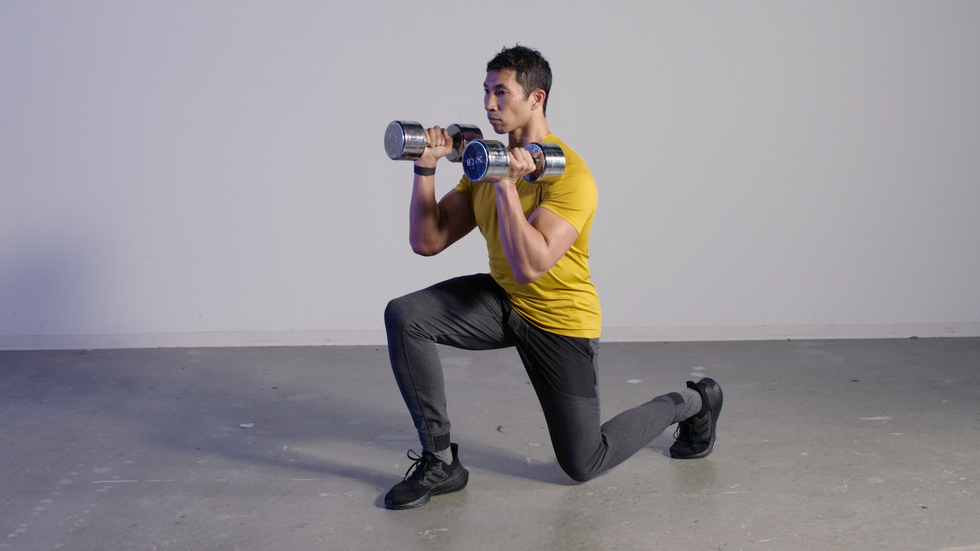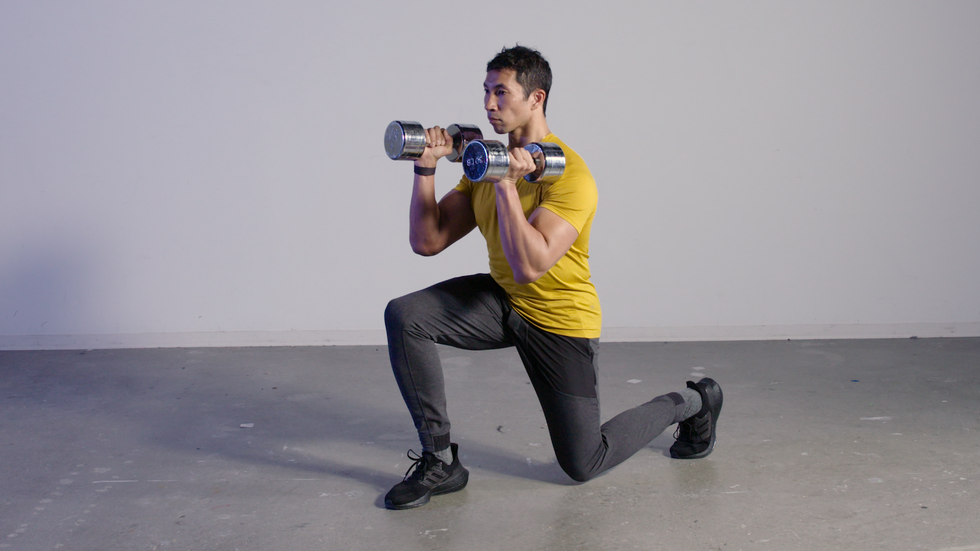YOU’LL NEVER GO wrong by adding lunges to your training routine. The question is, which variation of the leg day staple will be the best pick? Selecting the best lunge for your workout needs might feel as difficult as actually completing a set, with so many different load positions and form varieties to choose between.
One lunge variation will fit most training objectives, according to Men’s Health fitness director Ebenezer Samuel, C.S.C.S.: the dumbbell lunge. You’ll target your glutes and hamstrings, and because the dumbbell lunge is so customizable, you can load a ton of weight to make it a primary movement on leg day. If you reverse your lunge and step back, you’ll reap even more benefits. Since you’re working on hip extension, the reverse dumbbell lunge can also help to drive athletic movement. Depending on how you load the movement, your abs are going to be targeted, in the way of core stabilization and anti-rotation work.
“Make sure to master this move and this version of the move because there’s so many benefits,” Samuel says. “Whether you’re looking for strength, whether you’re looking for athleticism, keep dumbbell lunges in your workout.”
Benefits of the Dumbbell Lunge
You’ll target the big muscles of your legs, making the dumbbell lunge a valuable movement to build strength and muscle. When you step back for the reverse lunge, you’ll be working on hip extension, making it a key exercise to help hone athleticism and improve your posture. As you ramp up the weight, you’ll get a good grip challenge, too.
Muscles the Dumbbell Lunge Works
- Hamstrings
- Glutes
- Quads
- Core
- Forearms
Why the Dumbbell Lunge Is Customizable
One of the benefits of the dumbbell lunge is that it’s very customizable.
You can step forward or backward. Samuel prefers reverse lunges, since you’ll add more hip extension to the move as you drive your hips forward while squeezing our glutes. This is also easier on your knees.
You can also change how you hold the load. The most common technique is holding a weight in each hand in the “suitcase” position, which feels natural and is a perfectly fine variation—it’s also an easier way to simply pack on weight and go heavy. You can also mix things up. One way is from a rack position (holding dumbbells on your shoulders), which creates more of a core challenge than the standard. A mixed rack is performed with one dumbbell on the shoulders with the other remaining by your side, creating quite a bit of tension along your midsection.
Samuel’s preferred grip is the single-load dumbbell reverse lunge. In this instance, you’re holding just one dumbbell on the side as your working leg. The load imbalance will start to pull your torso toward that side—which means your core will have to fight that urge in order to keep your shoulders square throughout the move.
How to Do the Single-Arm Dumbbell Reverse Lunge
No matter the grip you choose, the dumbbell reverse lunge is performed pretty much the same way.
- Hold a dumbbell in one hand at your side, focus on keeping your body in a solid working position—squeezing your shoulder blades, abs, and glutes. Keep your free arm in a tight position to maintain balance and stability.
- Grip the dumbbell nice and tight—the heavier the weight the more your forearms will be challenged.
- Keep your shoulders and hips square to the front as you step back. Step slightly to the side.
- From here, lower down with your back knee coming to about an inch off the ground. Pause for a beat at the bottom.
- Drive off your front heel to stand, focusing on maintaining a tight squeeze with your glutes. (It’s also okay to lean forward slightly if needed—you don’t need to maintain a completely straight torso throughout the move.)
How to Add the Dumbbell Lunge to Your Workouts
You can use the dumbbell lunge as a secondary unilateral exercise following a heavy compound movement like squats or deadlifts. If you’re on the road or without access to a fully-stocked gym, dumbbell lunges make the perfect hotel gym leg day move.
Don’t be afraid to challenge yourself when you’re doing dumbbell lunges. Go as heavy as possible. That means you’ll do better keeping the reps low. You should start with three sets of six to 10 reps, especially if you add these after a heavy deadlift or squat session.
Jeff Tomko is a freelance fitness writer who has written for Muscle and Fitness, Men’s Fitness, and Men’s Health.
Brett Williams, a fitness editor at Men’s Health, is a NASM-CPT certified trainer and former pro football player and tech reporter who splits his workout time between strength and conditioning training, martial arts, and running. You can find his work elsewhere at Mashable, Thrillist, and other outlets.




Comments are closed.